How to install a Keystone Patch Panel?
In this article, we will focus on the installation of keystone patch panel. Previously, we have introduced many solutions for cable management, such as horizontal/vertical organizers, patch panels,
An Overview of Keystone Patch Panel
Before the installation, let’s have an overview of the keystone panel. This is also regarded as the preparation stage, which has a great impact on your following installation.
Keystone patch
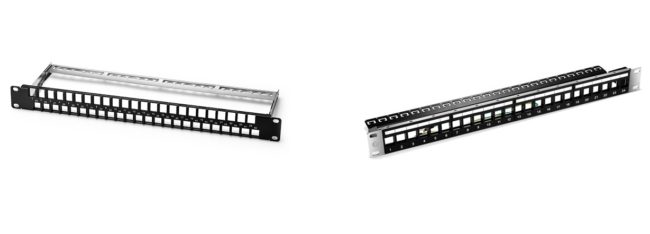
Figure 1: 48 Ports 1U Blank Keystone Patch Panel (Left) and 48 Ports 1U Blank Keystone Patch Panel (Right)
With different standards, such as ports and keystone jacks, the
According to ports, there are 24-port keystone patch panel and 48 ports panel version. Usually, the 24-port patch panel version is an unshielded/shielded Ethernet patch panel in a compact 1U with STP/UTP. It can accommodate all keystone jacks, including RJ45 Ethernet, HDMI audio/video, voice and USB applications. While the 48 ports panel version can be used as 1U rack-mount unshielded multimedia blank patch panel, also compatible with all keystone jacks.
Classified by keystone jacks, we can also get different types. When the keystone panel is inserted with jacks, we also call the panel as keystone jack panel. Among all kinds of RJ45 keystone jacks, Cat5e and Cat6 keystone jacks are used frequently.
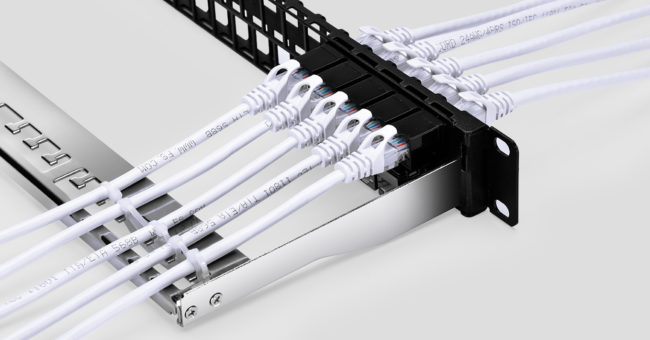
Figure 2: 48 Ports Blank Keystone Patch Panel Cabling
Installation Guide
After the preparation step, it’s time for us to move to the installation stage.
First, proper RJ45 jacks should be chosen. As we mentioned before, unlike pre-loaded or fixed patch panels, keystone patch panels have no built-in ports. Therefore, you need to decide the type and quantity of the jack at first.
Second, insert the RJ45 jacks. After choosing the proper RJ45 jack, it’s time for you
Third, install the equipped Ethernet patch panel into a 1U rack with the help of screws and screwdriver.
Fourth, plug cables that you have chosen into corresponding jacks you have inserted into the keystone patch panel.
Fifth, manage cables with the help of cable management accessories such as cable managers, lacing bars and cable ties.
If you are still unclear about the installing process, you can refer to the following video made by FS: Blank Keystone Patch Panel for Cat5e/Cat6 Ethernet Cabling.
Conclusion
Keystone patch panel just likes a joker for its easy matching. It can be customized for users’ cabling requirements. Moreover, installation is also easy to catch. In any case, the keystone panel is a wise choice for anyone requiring easy and direct access for Ethernet cabling.
Horizontal Cable Management VS Vertical Cable Management: Which to Choose?
Efficient cable management has been an indispensable aid for the cable organization, no matter it is vertical cable management or horizontal cable management. Owing to the more and more complicated network, a well-managed cabling has been a pressing job for most network installers and IT technicians. Therefore, a proper cable management means a lot to them. However, faced with two frequently used options, what on earth should they choose: vertical cable management or horizontal cable management?
Vertical Cable Management Basics
Conventionally, the vertical cable management refers to a solution to secure, bundle and route the cables at both sides of the racks, cabinets, or enclosures. In this management, cable managers can provide a vertical pathway for large numbers of cables from switches to patch panels in the rack system. These vertical cable managers are generally designed in height sizes up to 48U and width size up to 10 inches. The 3” and 5” are the most prevalent width sizes. In addition, the vertical cable managers are often made of metal and plastic. With a range of types of vertical cable management, the most popular vertical cable managers are 5U plastic vertical cable manager with bend radius finger, single D-ring vertical cable manager, and 45U 4.9" wide plastic vertical cable manager. You can refer to the Figure 1 for these three types as below.
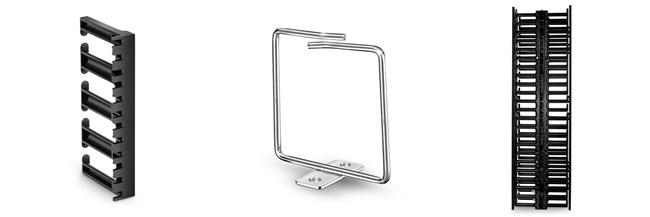
Figure 1: Vertical Cable Managers
Horizontal Cable Management Basics
In a horizontal cable management, it allows cable managers, placed in front of cabinets or racks, to manage all sorts of cables, like fiber, coax, patch cables, etc. In that way, cables can be well-organized and protected. It is typically one or two rack units high, or even higher if necessary. In the market, the horizontal cable management 1u version is easily found. Altogether, there are three common types of horizontal cable manager: horizontal cable managers with D-Ring, finger duct, or Brush Strip. You can refer to the Figure 2 as below.
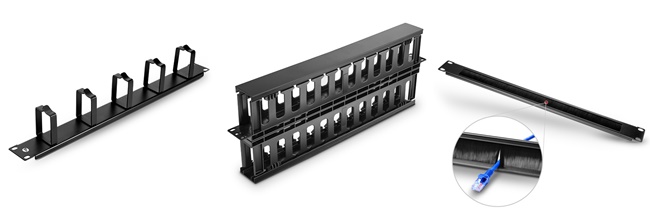
Figure 2: 1U Horizontal Cable Managers
A Comparison of Strengths
As a buyer, if you want to choose a proper cable management, it’s a must to know their advantages and benefits of each type. Actually, for cable management, no matter a vertical or horizontal way, they both share similar features. For example, they both greatly improve network performance by enhancing airflow and cooling efficiency and protecting cables from potential damages and dust, like improper bends, movement or sharp edges. Moreover, a neat management will also add aesthetic value to the working place. Besides, the two management ways also bear with their unique traits.
By reducing signal interference, the vertical cable management can greatly enhance the network performance. In a vertical cable management, it separates power with data cables within the racks, which greatly lower the chance for crosstalk and interference between them.
Additionally, cost reduction will also be the unique trait for vertical cable management. Vertical rack cable management with bend radius fingers is used with angled patch panel directly. In that way, the use of horizontal cable management panels can be reduced, which is a good way to save cost.
First, downtime minimized. Using a horizontal cable manager, cables can be settled in an ordered way instead of being tangled with each other. Especially, when something goes wrong, this will make technicians more easily to identify and access where goes wrong and fix it in far less time.
Second, growth promoted. By using horizontal cable managers, consolidating devices within racks or adding additional racks without messing up cables will no longer be a tricky task for IT technicians. Since cables are able to be identified easily, tracing what goes where in a move can be much easier at the time when you add new ports and cables. For your better understanding, you can refer to this 1u cable management device at below.
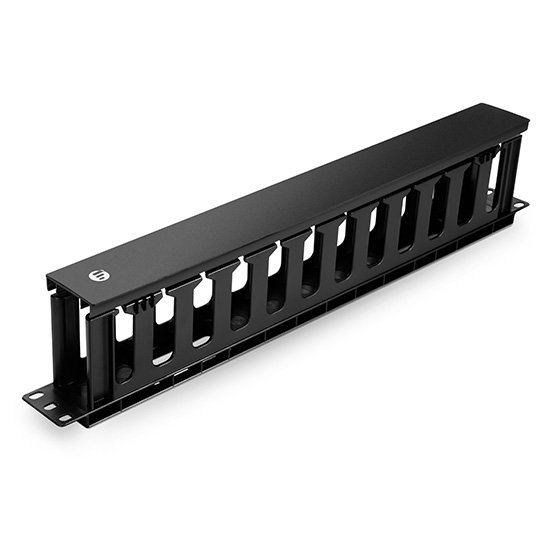
Figure 3: 1U Horizontal Cable Management Panel with Finger Duct
Buyers’ Guide
Just as the saying, the information makes winners. If you want to be a winner in cable organizing, there are mainly three steps you can follow. First, you need to have a proper planning before installations. Decide the number of cables and connections needed, and where the cables should be routed within the rack. Then you need to have a command of industry standards such as ANSI/TIA and ISO/IEC, as well as any federal, state or local regulations regarding cabling. According to that, you can start to choose your cable organizers. In fact, it’s hard to conclude which type is best when considering their similarities and peculiarities. It depends on actual conditions of your network, such as installing space, cable numbers, and sizes of your rack, etc. Sometimes, you may even find that a combination between vertical cable management and horizontal cable management suits you best.
Cisco SFP+ Module Wiki and Buying Tips
When it comes to optical modules, the brand Cisco especially their Cisco SFP+ modules will be mentioned by almost everyone in optic fiber field. As one of the worldwide leaders in IT and networking, Cisco has dedicated to networking equipment design and manufacture for several decades. Among their all sorts of product lines, SFP+ modules have enjoyed a widespread reputation. In the context of that, in this article, we are going to make an overall exploration of the Cisco’s superstar product: Cisco SFP+ module.
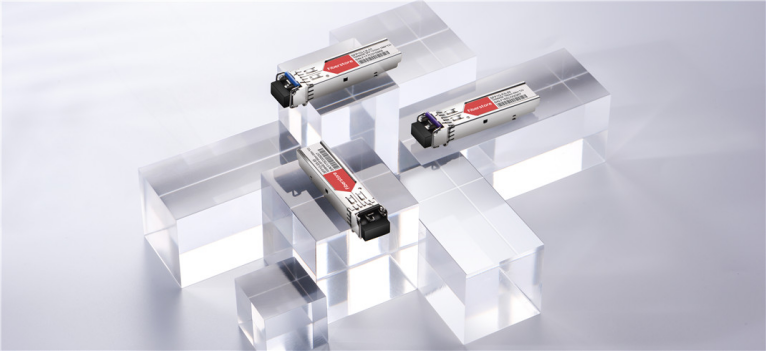
Figure 1: Cisco compatible 10G SFP+ modules
An Overview of the Cisco SFP+ Module
Like the general SFP+ transceivers, Cisco SFP+ modules are kinds of optical devices designed for 8 Gbit/s Fibre Channel, 10 Gigabit Ethernet and optical transport network standard OTU2, supporting data rates up to 16 Gbit/s.
Main features of Cisco SFP+ modules can be shared as below:
- Industry’s smallest 10G form factor for greatest density per chassis
- Hot-swappable input/output devices that plug into an Ethernet SFP+ port of a Cisco switch (no need to power down if installing or replacing)
- Supports “pay-as-you-populate” model for investment protection and ease of technology migration
- Optical interoperability with 10GBASE XENPAK, 10GBASE X2, and 10GBASE XFP interfaces on the same link
- Hot-swappable input/output devices that plug into an Ethernet SFP+ port of a Cisco switch (no need to power down if installing or replacing)
- Cisco quality identification (ID) feature enables a Cisco platform to identify whether the module is certified and tested by Cisco
With various Cisco SFP+ module types, a wide variety of 10 Gigabit Ethernet connectivity options for diverse networking environments, like data centers, enterprise wiring closet, and service provider transport applications can be offered. Altogether, Cisco SFP+ modules consist of Cisco SFP-10G-SR, SFP-10G-LR (LRM), SFP-10G-ER and SFP-10G-ZR, etc. You can refer to the table displayed as below for detailed specifications of Cisco SFP+ modules.
|
Cisco SFP+
|
Wavelength (nm)
|
Interface
|
Cable Type
|
Core Size (Microns)
|
Cable Distance
|
|
Cisco SFP-10G-SR-S
|
850 |
Dual LC/PC |
MMF |
62.5 |
26 m
|
|
Cisco SFP-10G-SR
|
33 m
|
||||
|
Cisco SFP-10G-SR-X
|
50
|
66/82/300/400 m
|
|||
|
Cisco SFP-10G-LRM
|
1310 |
Dual LC/PC |
SMF/MMF
|
G.652/62.5/50
|
300/100/220 m
|
|
Cisco SFP-10G-LR-S
|
SMF |
G.652 |
10 km |
||
|
Cisco SFP-10G-LR
|
|||||
|
Cisco SFP-10G-LR-X
|
|||||
|
Cisco SFP-10G-ER-S
|
1550 |
Dual LC/PC |
SMF |
G.652 |
40 km |
|
Cisco SFP-10G-ER
|
|||||
|
Cisco SFP-10G-ZR-S
|
80 km |
||||
|
Cisco SFP-10G-ZR
|
|||||
|
Cisco FET-10G
|
850
|
Dual LC/PC
|
MMF
|
50
|
25/100 km
|
|
Cisco SFP-10G-BXD-I
|
1330
|
Dual LC/PC |
SMF |
G.652 |
10 km |
|
Cisco SFP-10G-BXU-I
|
1270
|
||||
|
Cisco SFP-10G-BX40D-I
|
1330
|
40 km |
|||
|
Cisco SFP-10G-BX40U-I
|
1270
|
How to Choose Cisco SFP+ Modules?
If you want to buy Cisco SFP+ modules, it’s sensible to put their optimum transmission distance and compatibility with other Cisco devices into consideration.
As for the transmission distance, basically, the ranges between 100 m to 400 m and 10 km to 80 km are commonly seen. For the distance from 100 m to 400 m, we usually use Cisco 10G multimode SFP+ transceiver. For example, if you want to buy a Cisco SFP+ module for transmission within 300 m, then the Cisco SFP-10G-SR module will be the best choice. More information about the optimum transmission distance of Cisco SFP+ modules, you can refer to the table above.
Apart from distance, another important thing you should be clear about is the SFP+ module’s compatibility with other Cisco devices. You may wonder if this Cisco SFP+ Module can connect with other devices, such as SFP modules. The answer is NO. For example, If you connect the SFP-10G-SR with Cisco GLC-SX-MMD SFP transceiver (1 Gbps only), they may not be able to work. Since the SFP-10G-SR only runs at 10 Gbps link rate, it means you force SFP-10G-SR to use 1Gbps speed. You can never interconnect them. For more details about the compatibility of Cisco modules, you can search it from their online Compatibility Matrix.
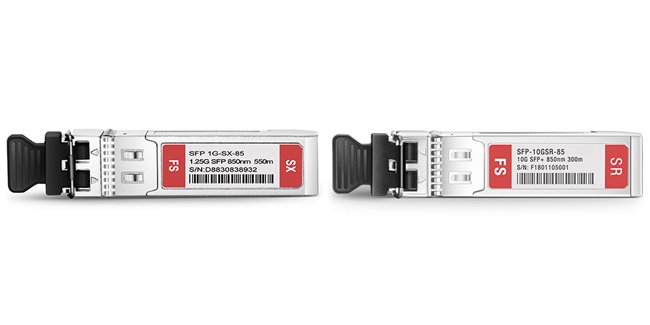
Figure 2: Cisco SFP-10G-SR (Right) and Cisco GLC-SX-MMD SFP (Left)
By the way, Cisco SFP+ module price sometimes is also troublesome for many buyers. When you search Cisco SFP+ modules online, you will find the price of these modules from original brand retailers is not economical. Therefore, in recent years, using non-original brand retailers optical transceivers in
Conclusion
As a leading role in fiber optic network, Cisco SFP+ module has been witnessed a glorious period. But with the unremitting efforts of other manufacturers, undoubtedly, other non-original brand retailers brands will be seen on the rise. For sure, the FS.COM will be that great case.
Top of Rack VS End of Row: Which to Choose for Data Center Network
The topic, top of rack vs end of
Top of Rack (ToR) Design
In a Data Center, there are several racks of servers or storage equipment. Each rack contains multiple computing devices. The top of rack architecture recommends network fiber switches should be placed in every rack to connect with all the computing devices in the rack. In turn, these network switches will be connected to aggregation switches via fiber optic cables.
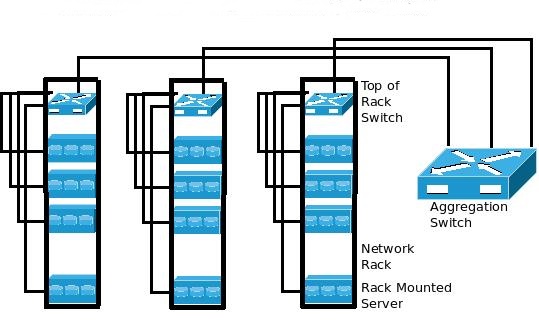
Figure 1: Top-of-Rack Network Connectivity
Notably, the top-of-rack switch, like a gigabit Ethernet switch, can be put anywhere in the rack, not just limited at the top. However, when in applications, the engineers prefer to put on the top instead of the middle or bottom of the rack for their easier accessibility and cleaner cable management.
End of Row (EoR) Design
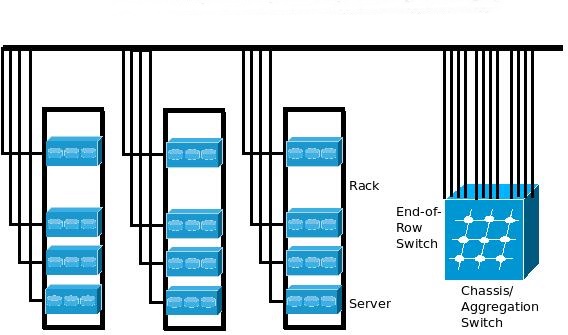
Figure 2: End-of-Row Network Connectivity
Just like the top-of-rack switch, the end of row switch may not just be placed at the end of each actual row. Even just a handful of network racks collectively placed in a small row of their own, the end of row switch is still available to provide copper connectivity for more than one row of servers.
Top of Rack vs End of Row
Top of rack vs end of row data center designs
The top of rack switching can relieve the complexity of cabling and increase the efficiency of on-site deployment. For the reason that all the servers in the same server cabinet are connected to the switch, like 10GBE switches in the same rack, only a few cables go outside the rack reaching to the aggregation switch. In thus doing, fewer cables are installed between the server and network racks, which contributes to a reduction of cable cost. Moreover, this design enables easily upgrade from 1GE/ 10GE network to 10GE/ 40GE network in the future with minimum costs and changes to cabling. In the EoR design, the number of the device is decreased because not every rack needs to be equipped with switches. Undoubtedly, less rack space is required in the architecture. With fewer devices in the data center, requirements for the cooling system will be reduced which also can save the electric power.
For the ToR, with cables reduced, the number of racks is still increased. The management for switches will be a little bit tricky. In addition, the ToR approach takes up more rack space for the installation of switches. As for the EoR, with fewer switches used, more cables are needed between racks resulting in the higher possibility of cable mess and higher cost for higher performance cables. Besides, it’s difficult and more expensive to upgrade cabling infrastructure to support higher speed network. Lengthier cables need to be replaced individually while upgrading from 1GE to 10GE, for example.
Conclusion
Top of rack vs end of row data center designs are the common deployments for data center architecture. Considering that each type bears with benefits and limits, you can hardly tell which one is best. Just as the saying, the most suitable, the best.
Rack Enclosure Basics and Buying Guide
Rack enclosure, an effective solution to a tidy rack cable environment, has been a popular choice for IT technicians. Conventionally, being a kind of cable organizer, the rack mount enclosure is widely used in data centers to house, organize, manage and protect fiber optic cables. With such great significance, it’s necessary for us to explore this device.
Rack Enclosure Basics
In the beginning, let’s drive from physical features of the rack mount enclosure, including rack units, accessible types, and loaded items.
Specifically, the rack enclosure is designed into a 19-inch rack mount. When it comes to application, the rack units of this fiber optic enclosure are available in 1U, 2U, 3U, and 4U in the market. Usually, users may prefer to choose two or more 1U

Figure 1: Rack Enclosure Units
Since the rack mount enclosure 1U version is commonly used in organizing server rack, we take 1U rack mount for a case to study this feature. Altogether, there are three types of rack enclosures: cover removable, slide-out, and swing-out fiber enclosures.
Compared with a cover removable type, the slide-out and swing-out fiber enclosures are more favored. Neglecting the fact that the cover removable type is the cheapest one among these three types, the slide-out
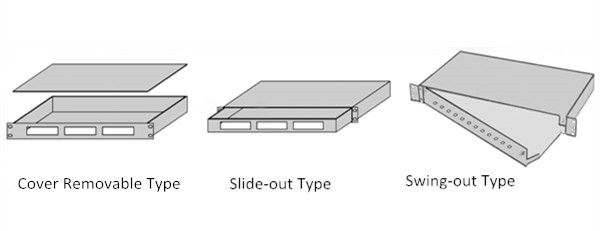
Figure 2: Accessible Types of Rack Enclosure
Catering to different requirements for cabling, different accessories are loaded with rack mount enclosures: fiber adapter panels (FAPs) and MPO/MTP cassettes.
A rack enclosure with FAPs can be applied in both pre-terminated and field-terminated cabling environments. Generally, adapter patch panels are available to connect with LC, SC and MPO/MTP fiber cables. According to adapter numbers on FAPs, rack mount enclosures can support up to 96 fibers. In most cases, a 1U
Besides FAPs, rack enclosures can also be loaded with MPO/MTP cassettes, providing secure transitions between MPO/MTP and LC or SC connectors. As a pre-terminated rack mount patch panel, this rack enclosure is designed to achieve interconnections between MTP/MPO backbone and LC/SC patching. When in a 1U rack space, rack mount enclosures loaded with MPO/MTP cassettes can support up to 144

Figure 3: Rack Enclosure loaded with FAPs or MPO/MTP Cassette
Buyers’ Guide
Through the above basic introduction of the rack enclosure, we can find it can never be an easy task to select a suitable rack enclosure. There are many factors you need to consider, such as rack units, accessible types, and loaded items. Still, there are other factors needed to be taken into considerations, such as the number of ports you need. And when it comes to the patch panel, you have to figure out whether the fixed or removable front panels are needed. Besides, you still need to think about the way to do fiber termination: splicing or pre-terminated. Last, but not the least, your budget for this purchasing. Obviously, all these factors, mentioned or not in this article, can have an impact on configurations or combinations of rack enclosures, contributing to your final decision. By the way, if you are looking for the detailed guidance of a 1U rack enclosure, you can refer to the article FS 1U Rack Enclosure Types and Selection Guide.
Managed Gigabit Switch Buying Guide
Nowadays, the managed Gigabit switch has been a hot cake in small and medium enterprise networks. In the context of that, it’s necessary for us to catch the trend and learn something about the managed Gigabit switch so that you can buy it more wisely.
What Is Managed Gigabit Switch?
Before we introduce the managed gigabit Ethernet switch, let’s overview the background information of it firstly. Gigabit Ethernet switch, also called network switch, refers to a box-like device connecting together a number of other devices, such as computers, printers, and servers on a Local Area Network (LAN) and utilize the packet switching to forward data to and from those connections.
While a managed switch is a kind of fiber switch offering a more tailored experience to users. It not only offers tools and the means to monitor the network, but also control over LAN traffic. Managed switches are very much like Virtual Private Servers where you'll be in charge of setting everything up, managing the device and take responsibility for any configurations that cause downtime.
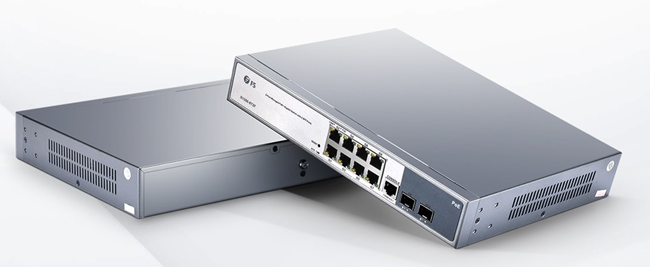
Figure 1: 1GE PoE+ Series Managed Switches
How to Choose a Managed Gigabit Switch as Required?
According to different features and standards, such as the managed level and the number of ports, the managed Gigabit switch can be grouped into different types. And users can select the required managed switches based on these features.
Based on different managed levels, the managed Gigabit switch can be grouped into the partially managed (smart) switch and fully managed (enterprise) switch. Smart switches have a limited number of options for configuration. However, comparing with the fully managed switch, it can be a cheap managed gigabit switch for home and office use. While fully managed switches are targeted at servers and enterprises, offering a wide array of tools and features to manage the complicated network better.
Classified by the number of ports, the managed Gigabit switch has been known in a different way. Typically, there are four types are commonly found in the market: 8-port managed gigabit switch, 16-port managed gigabit switch, 24-port managed gigabit switch, and 48-port managed gigabit switch. These ports may be a combination of SFP or SFP+ slots for fiber connectivity, but more commonly they are copper ports with RJ-45 connectors on the front, allowing for transmission distances up to 100 meters. With fiber SFP modules, the distances can be supported up to 40 kilometers.
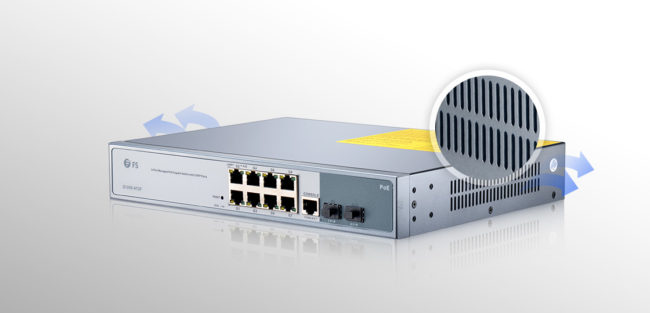
Figure 2: 8-Port Gigabit PoE+ Managed Switch with 2 SFP
After we have a basic idea of types of managed Gigabit switches. it’s time to remind you some factors should be taken into consideration when you buy a managed Gigabit switch. Firstly, you should clear about the location you want to install whether just for home, office or enterprise. It decides that whether you need to buy a partially managed switch or a fully managed switch.
Then you should review your network environment and think about the number of users your network supports. In a short, the larger your organization is, the more ports you’ll need. For example, if you are a home user, an 8 or 24 port switch is enough, but a 48 port switch, designed for medium or larger network environment, will be a waste of resource.
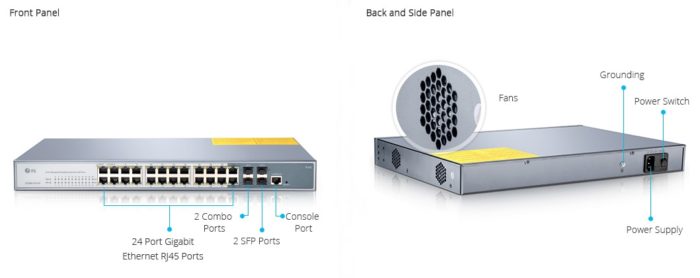
Figure 3: 24-Port Gigabit PoE+ Managed Switch with 4 SFP
Conclusion
Through this idea, we can have a basic mind about the background information of the managed Gigabit switch, such as meaning and types. Moreover, we also offer some tips for people who want to buy it. Hope this article can help you choose a right managed Gigabit switch.
Tips on Buying Fiber Optic Cables
Buying fiber optic cables has been a daily thing in our life. Since the field of fiber optic network is still unfamiliar to most people, not to say the detailed information about the fiber optic cable. In this article, we are going to provide some tips for you to buy fiber optic cables. Before that, let’s go over the background information of the fiber optic cable for your better understanding.
What Is the Fiber Optic Cable
The fiber optic cable refers to a kind of telecommunication cable, containing one or more glass or plastic made optic fibers, usually slightly wider than a human hair. It can carry light to transmit data. Designed for long distance transmission from hundreds of miles to thousands of miles, the fiber optic cable is an ideal choice for networking, telecommunications and storage applications in wiring closets, distribution frames, gateways, central offices and data centers.
Types of Fiber Optic Cables
According to different standards or features, there are different types of fiber optic cables. Basically, based on different transmission modes, the fiber optic cable can be grouped into two types: single mode fiber and multimode fiber.
The fiber optic cable for this type is a single strand of glass fiber with a diameter of 8.3 to 10 microns, which is narrower than the multimode fiber. Under such a condition, the beam of light is transmitted in a much tighter space with a higher transmission rate. Therefore, it makes the long-distance communication, sometimes as far as between continents more available.
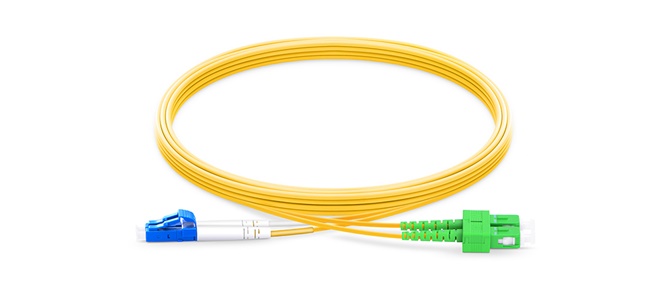
Figure 1: Single Mode Bend Insensitive Fiber Optic Cable
Compared with single mode fibers, the multimode fiber has a larger diameter (62.5µm or 50µm), allowing more space to generate and collect light. Considering about multimode fibers’ transmission performance, it is mostly used for communications over short distances no longer than 2000 m, such as within a building or in a small campus.
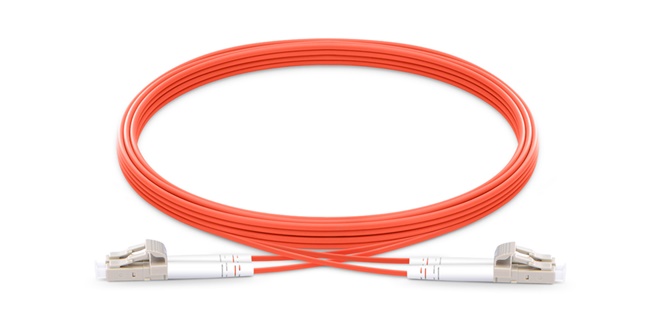
Figure 2: OM1 Multimode Fiber Optic Cable
Tips on Buying Fiber Optic Cables
After an overview of fiber optic cables, it’s time for us to learn how to buy fiber optic cables. There are some major steps offered to follow with.
Firstly, preparation. For anyone buying fiber optic cables, they need to have a full preparation. On the one hand, you need to know your network environment, such as the required transmission speed, distance etc. On the other hand, you need to have a basic understanding of the features of all kinds of optic cables. As we mentioned above, there are many types of fiber optic cables available in the market not only just based on different transmission modes, for example, according to different connectors, there are LC fiber, SC fiber, etc. Therefore, you need to know which type suits your network environment.
Next, you need to have a budget for buying optic cables in your mind. There are so many fiber optic cable suppliers in the online market, almost every supplier will offer a different fiber optic cable price. After that, you can begin your online searching. When you browse the product, you can make a comparison of the fiber optic cable price per meter among different suppliers. Besides, you have to check the suppliers’ reputation making sure their service and products are reliable.
Last, but not least. Some buyers buying fiber optic cables for their company need to consider more carefully for their complicate requirements. You had better buy your cables from suppliers who are also manufacturers, such as FS.COM, one of the top fiber optic cable manufacturers. Their service will be more mature, reliable and professional, especially for their after-sale service.
Conclusion
Buying fiber optic cable is not so difficult as you have thought. After reading this article, we believe things will be different for you.